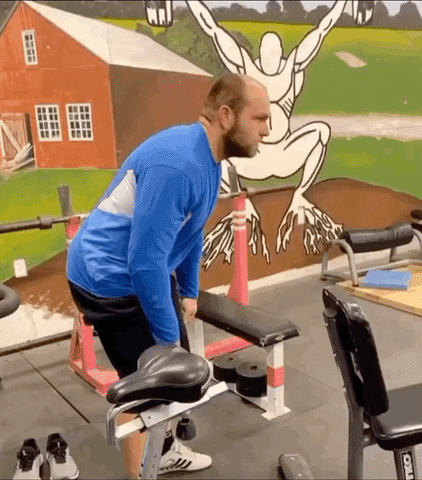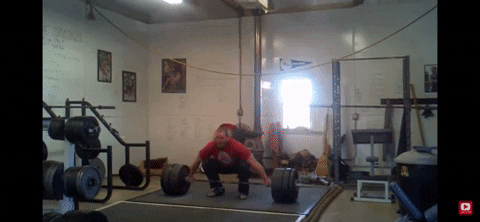The TRUTH about Triple Extension
FREE WEIGHTLIFTING WORKOUT!
Download by entering below

Truth About Triple Extension
Triple extension is one of those concepts that can be a mythical discussion. A lot of diehards believe it has to happen. And then there is another camp that thinks it is a byproduct of everything else that is happening. Triple extension becomes this gray area in the world of weightlifting.
But first, let’s go into what is actually happening with triple extension. Envision finishing a snatch. We will see the ankle fully plantar flexed, the knees fully extended, and the hips fully extended as the lifter is at the top of their pull. THIS is when triple extension happens. At the top of a snatch and the final extended position of the clean.
Is triple extension a coachable position? And if it is coachable, how do people do it? A lot of coaches cue to jump at the finish, which might lead to triple extension. Other coaches will say to really plantar flex and get up on the toes at the finish. Some coaches will use sequencing like ankles, knees, hips, as though the athlete will finish with plantar flexion first, knee extension second, and hip extension third. Like I said, this creates a lot of gray areas.

Setting The Feet
Are there examples of athletes who have been really, really good at weightlifting who didn’t actually triple extend? Yep. There are examples. I’ll start by bringing up Yuri Vardanian. Looking at his videos now, a lot of coaches will argue that he doesn’t fully plantar flexed. Yes, there is slight plantar flexion, but nothing like the amount of plantar flexion you see from someone like Guo. Another athlete, Akayev, who is known for snatching 210 kilos in training as a 105 kilo lifter. In some of his videos, specifically his 210 kilo snatch, he doesn’t achieve full knee extension. Some individuals who tend to jump back a bit more might not achieve full knee extension because their hips extend so much.

Does Triple Extension Transfer To Sports Performance?
Is it important to coach triple extension in the snatch and clean outside of weightlifting? Asking more questions, Is it about triple extension or is it more about the rate of coordination, improvement in mobility, and the importance of force absorption when transferring over to the world of athletics?
Piggybacking on those questions, I want to bring up Al Vermeil. Mr. Vermeil was the strength and conditioning coach for the Chicago Bulls when they won the titles in the 90’s and he was also the strength and conditioning coach for the Bears in the 80’s. Al discussed the importance of triple flexion. Having dorsiflexion in the ankles, flexion in the knees, and flexion in the hips when catching a clean or snatch was a position that was actually more transferable to sports because it is the position that needs to be the strongest for athletes to be successful. So Al used all these different snatch and clean variations that were more likely to lead to the flexion position.
If we are thinking about transfer to athletics, triple flexion is actually where we need to focus. The catch in the clean and the catch in the snatch is more important than triple extension through this mindset.

Do We Have To Coach Triple Extension?
From this analysis of triple flexion, I got to thinking. Do we have to coach triple extension or is triple extension happening because of what occurs in the pull? And then do we need triple extension to achieve triple flexion in the catch? I don’t think triple extension is necessary to achieve triple flexion.
As coaches, we need to start by focusing on the technical patterning behind the concept of triple extension. The second big concept has to do with cueing the movement, yes or no? Which brings in a much deeper aspect behind technical movement and technical coordination in weightlifting movements. In most cases, technique is built around what happens in the previous position. Think about triple extension occurring at the finish of a snatch or clean. That thought in mind, we can work backward and know that what happens prior to that position, prior to the finish, is most likely going to be key.

So again, I got thinking. Triple extension happens for most lifters, not all lifters. And we have to think about prioritizing the position before extension, which happens to be where the reciprocation point is in the pull. Remember, in the pull, we first want the knees to clear back. As the bar comes around the knees, we want the bar to be as tight as possible. This is where we see the reciprocation point (the knees coming under the bar to keep the bar tight to the center of the mass); we can’t just pull the bar into our knees. We have to get our knees underneath while we stay flat-footed and while the chest stays forward. This brings in the concept of triple flexion.
As the bar enters the reciprocation point and comes up into the hip, we will see dorsiflexion in the ankles as the heels stay flat, knee flexion to get the knees under the bar, and we will see hip flexion. Meaning, we are seeing triple flexion before we ever see triple extension. Understand that when the knees come forward, there is a lengthening on the Achilles and a little bit more of a stretch on the hamstrings. The hamstrings will eventually create hip extension.
Everything working together around the joints of the knees and hips achieve co-contractions to stabilize and dampen neural noise, which in turn leads to hip extension and knee extension. Another little nugget, I believe hip extension occurs prior to knee extension with most athletes.
The truth behind triple extension is actually understanding the triple flexion position. A big finish is a result of prior positions in the pull. We also need to understand how the reciprocation point comes into play as well. Finally, we need to understand co-contractions to stabilize joints and also to achieve greater stretch reflexives to have a more vertical finish.
Recap
I don’t believe we need to cue triple extension. The key position from the floor to the knee is tantamount to setting up the rest of the lift to be successful. The prior positions are much more important to be taken care of and need to be held in a higher regard to make athletes capable of achieving monster finishes. A real important point here is that all of these positions rely on how the knees move–coming back and under the bar.
I can’t stress enough that we shouldn’t be cueing triple extension. Cueing triple extension is just putting a band-aid over the problem instead of actually fixing the pull position. Fixing the pull position will lead to a better position at the top. The only cue I like for the finish is to think of the finish as a flat footed jump (there is a great variation to train this, a flat footed snatch, that teaches athletes how to keep the bar extremely tight and still finish).
The most paramount concept is that anything that happens prior to a position leads to the result of the next position. So don’t cue triple extension on the finish because everything goes back to what happened prior.
Related Posts
Blog Topics

Yo, It's Dane
Welcome to the Garage Strength Blog, where it is my goal to provide you with the experience and knowledge I've gained in the strength and conditioning world over many years of learning from both successes and failures. I train elite-level athletes in a multitude of sports from the high school to professional levels, already producing 5 Olympics and 30+ National Champions. If you want to be the next champion I train, check out my strength programs below!
Start Training With Me

Join for free educational videos EVERY WEEK on strength coaching and athletic performance



